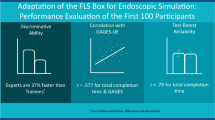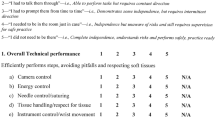Abstract
Background
Preclinical simulator training has the potential to decrease endoscopic procedure time and patient discomfort. This study aims to characterize the learning curve of endoscopic novices in a part-task simulator and propose a threshold score for advancement to initial clinical cases.
Methods
Twenty novices with no prior endoscopic experience underwent repeated endoscopic simulator sessions using the part-task simulator. Simulator scores were collected; their inverse was averaged and fit to an exponential curve. The incremental improvement after each session was calculated. Plateau was defined as the session after which incremental improvement in simulator score model was less than 5%. Additionally, all participants filled out questionnaires regarding simulator experience after sessions 1, 5, 10, 15, and 20. A visual analog scale and NASA task load index were used to assess levels of comfort and demand.
Results
Twenty novices underwent 400 simulator sessions. Mean simulator scores at sessions 1, 5, 10, 15, and 20 were 78.5 ± 5.95, 176.5 ± 17.7, 275.55 ± 23.56, 347 ± 26.49, and 441.11 ± 38.14. The best fit exponential model was [time/score] = 26.1 × [session #]−0.615; r 2 = 0.99. This corresponded to an incremental improvement in score of 35% after the first session, 22% after the second, 16% after the third and so on. Incremental improvement dropped below 5% after the 12th session corresponding to the predicted score of 265. Simulator training was related to higher comfort maneuvering an endoscope and increased readiness for supervised clinical endoscopy, both plateauing between sessions 10 and 15. Mental demand, physical demand, and frustration levels decreased with increased simulator training.
Conclusion
Preclinical training using an endoscopic part-task simulator appears to increase comfort level and decrease mental and physical demand associated with endoscopy. Based on a rigorous model, we recommend that novices complete a minimum of 12 training sessions and obtain a simulator score of at least 265 to be best prepared for clinical endoscopy.


Adapted from Hart SG, Staveland LE. Development of NASA-TLX (Task Load Index): Results of Empirical and Theoretical Research. Advances in Psychology. 1988;52:139–183



Similar content being viewed by others
References
ASGE Training Committee (2012) Principles of training in GI endoscopy. Gastrointest Endosc 75(2):231–235
Cohen J, Cohen SA, Vora KC et al (2006) Multicenter, randomized, controlled trial of virtual-reality simulator training in acquisition of competency in colonoscopy. Gastrointest Endosc 64:361–368
Sedlack RE, Kolars JC (2004) Computer simulator training enhances the competence of gastroenterology fellows at colonoscopy results of a pilot study. Am J Gastroenterol 99:33–37
Gerson LB (2006) Evidence-based assessment of endoscopic simulators for training. Gastrointest Endosc Clin N Am 16:vii–viii
Haycock AV, Youd P, Bassett P et al (2009) Simulator training improves practical skills in therapeutic GI endoscopy: results from a randomized, blinded, controlled study. Gastrointest Endosc 70:835–845
Shirai Y, Yoshida T, Shiraishi R et al (2008) Prospective randomized study on the use of a computer-based endoscopic simulator for training in esophagogastroduodenoscopy. J Gastroenterol Hepatol 23:1046–1050
Thompson CC, Jirapinyo P, Kumar N (2014) Development and initial validation of an endoscopic part-task training box. Endoscopy 46(9):735–744
Chung J, Kim N, Um MS et al (2010) Learning curves for colonoscopy: a prospective evaluation of gastroenterology fellows at a single center. Gut Liver 4(1):31–35
Ward ST, Mohammed MA, Walt R et al (2014) An analysis of the learning curve to achieve competency at colonoscopy using the JETS database. Gut 63:1746–1754
Lane NE (1987) Skill acquisition rates and patterns: issues and training implications. Springer, New York
Schmidt RA, Lee TD (1999) Motor control and learning: a behavioral emphasis, 3rd ed. Human Kinetics, Windsor
Obstein KL, Patil VD, Jayender J et al (2011) Evaluation of colonoscopy technical skill levels by use of an objective kinematic-based system. Gastrointest Endosc 73(2):315–321
Jirapinyo P, Kumar N, Thompson CC (2015) Validation of an endoscopic part-task training box as a skill assessment tool. Gastrointest Endosc 81(4):967–973
Hart SG, Staveland LE (1988) Development of NASA-TLX (Task Load Index): Results of Empirical and Theoretical Research. Adv Psychol 52:139–183
Vera AM, Russo M, Mohsin A et al (2014) Augmented reality telementoring (ART) platform: a randomized controlled trial to assess the efficacy of a new surgical education technology. Surg Endosc 28(12):3467–3472
Ferlitsch A, Schoefl R, Puespoek A et al (2012) Effect of virtual endoscopy simulator training on performance of upper gastrointestinal endoscopy in patients: a randomized controlled trial. Endoscopy 42(12):1049–1056
Ahlberg G, Hultcrantz R, Jaramillo E et al (2005) Virtual reality colonoscopy simulation: a compulsory practice for the future colonoscopist? Endoscopy 37(12):1198–1204
Cohen J, Cohen SA, Vora KC et al (2006) Multicenter, randomized, controlled trial of virtual-reality simulator training in acquisition of competency in colonoscopy. Gastrointest Endosc 64(3):361–368
Ward ST, Hancox A, Mohammed MA, et al (2016) The learning curve to achieve satisfactory completion rates in upper GI endoscopy: an analysis of a national training database. Gut. [Epub ahead of print]
Koch AD, Ekkelenkamp VE Haringsma J et al (2015) Simulated colonoscopy training leads to improved performance during patient-based assessment. Gastrointest Endosc 81(3):630–636
Acknowledgements
Materials and financial support were provided by the Department of Medicine, Brigham and Women’s Hospital; Harvard Digestive Diseases Center at Harvard Medical School (DK034854); and the Center for Integration of Medicine and Innovative Technology (CIMIT).
Author contributions
P. J: Study design, data collection and analysis, drafting and revision of the manuscript; W. A: Data analysis and drafting of the manuscript; H. A: Data collection; T. Z: Data collection; C. T: Data collection; A. I: Study design and data collection; C. T: Study design and critical revision of the manuscript.
Author information
Authors and Affiliations
Corresponding author
Ethics declarations
Disclosures
Dr. Jirapinyo reports personal fees from Endosim during the conduct of the study. Dr. Thompson reports personal fees from Olympus and personal fees from Endosim during the conduct of the study. Aihara, Zaki, Tsay, and Imaeda report no conflict of interest.
Rights and permissions
About this article
Cite this article
Jirapinyo, P., Abidi, W.M., Aihara, H. et al. Preclinical endoscopic training using a part-task simulator: learning curve assessment and determination of threshold score for advancement to clinical endoscopy. Surg Endosc 31, 4010–4015 (2017). https://doi.org/10.1007/s00464-017-5436-x
Received:
Accepted:
Published:
Issue Date:
DOI: https://doi.org/10.1007/s00464-017-5436-x




